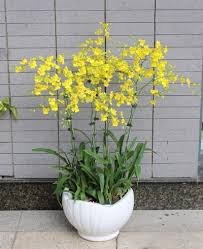**How to Care for Dancing Lady Orchids (Oncidium) for Long-Lasting Beauty**

The Dancing Lady Orchid, or Oncidium, is loved for its unique, delicate flowers that resemble a dancer’s flowing gown. Native to tropical and subtropical regions, this orchid is both striking and relatively easy to care for with the right techniques. This comprehensive guide provides detailed insights on the best practices for maintaining the health and beauty of Dancing Lady Orchids indoors, including light requirements, watering schedules, ideal temperatures, and troubleshooting tips.
### 1. Understanding the Basics: Why Proper Care Matters for Oncidium Orchids
Oncidium orchids are known for their intricate blooms in shades of yellow, pink, red, and white. The name “Dancing Lady” is inspired by the flower’s shape, which resembles a dancing figure. Unlike some orchid species, Oncidium orchids are hardy but have specific needs. Caring for them attentively helps ensure they grow strong and bloom year after year.
### 2. Choosing the Perfect Location: Light and Temperature Needs
#### A. Light Requirements
Oncidium orchids require bright, indirect light. Unlike other orchids that may thrive in low light, these orchids need ample light to produce vibrant blooms. A spot near an east or west-facing window is ideal.
– **Ideal Light Levels:** Bright, indirect light (approximately 2,000–3,000 foot-candles).
– **Signs of Light Issues:** Dark green leaves indicate insufficient light, while reddish or yellowish leaves may mean too much light exposure.
Consider using sheer curtains to diffuse intense light, or supplement with fluorescent or LED grow lights if natural light is inadequate. Proper lighting is essential for flowering, as insufficient light can lead to a lack of blooms.
#### B. Temperature Preferences
Dancing Lady Orchids thrive in a consistent temperature range:
– **Daytime:** 65–75°F (18–24°C)
– **Nighttime:** 55–60°F (13–16°C)
These orchids appreciate a slight nighttime temperature drop, which helps promote blooming. Avoid placing them in areas with sudden temperature changes, such as near heating or air conditioning vents.
### 3. Ensuring Proper Humidity and Air Circulation
#### A. Humidity Needs
Oncidium orchids thrive in moderate to high humidity, ideally between 40% and 60%. If your indoor environment is dry, especially in winter, you can increase humidity using:
– **Humidity Trays:** Place a shallow tray filled with water and pebbles under the pot. As the water evaporates, it increases the humidity around the plant.
– **Humidifiers:** Placing a small room humidifier near the orchid can help maintain a stable humidity level.
– **Grouping Plants:** Placing multiple plants together can naturally boost humidity levels in a small area.
#### B. Air Circulation
Good air circulation is essential to prevent mold and fungal infections. Avoid stagnant air, which can trap moisture around the leaves and roots. Placing a small fan nearby (set on low) can help promote airflow without directly blowing on the orchid.
### 4. Watering the Right Way: Frequency and Technique
Oncidium orchids require consistent moisture but are sensitive to overwatering, which can lead to root rot.
#### A. Watering Frequency
Watering frequency varies with seasonal changes and indoor conditions. Generally, you should water:
– **Once a week** during the growing season (spring and summer).
– **Every 10–14 days** during the dormant period (fall and winter).
Always check the potting medium’s moisture level by inserting your finger about an inch deep. If it feels dry, it’s time to water.
#### B. Proper Watering Technique
To water an Oncidium orchid:
1. Place the pot in a sink or basin.
2. Slowly pour water over the medium until it’s thoroughly soaked.
3. Allow all excess water to drain completely before returning the pot to its display area.
#### C. Water Quality
Use filtered, distilled, or rainwater to avoid chlorine and mineral buildup, which can be harmful over time. If using tap water, let it sit for 24 hours to allow chlorine to dissipate.
### 5. Choosing the Ideal Potting Medium and Repotting Schedule
The right potting medium and container play a vital role in orchid health, as they provide necessary drainage and aeration.
#### A. Potting Medium
Oncidium orchids typically require a fast-draining medium. A blend of fir bark, sphagnum moss, and perlite works well, as it holds enough moisture without becoming overly soggy.
#### B. Repotting Frequency
Repotting is usually needed every 1–2 years or when the potting medium begins to break down. The best time to repot is in spring, just before the growing season begins.
**Repotting Steps:**
1. Gently remove the orchid from its pot and shake off the old medium.
2. Trim any dead or decayed roots with sterilized scissors.
3. Place the orchid in a new pot, spreading the roots over fresh potting medium.
4. Water lightly after repotting to help the plant settle in.
### 6. Fertilizing for Optimal Growth and Blooming
Regular fertilization encourages healthy growth and vibrant blooms.
#### A. Type of Fertilizer
A balanced, water-soluble fertilizer (20-20-20) is suitable for Oncidium orchids. You may also use a special orchid fertilizer.
#### B. Fertilizing Schedule
– During the growing season (spring and summer): Fertilize every 2 weeks.
– During dormancy (fall and winter): Fertilize once a month or reduce strength by half.
**Note:** Always dilute the fertilizer to half the recommended strength. Over-fertilizing can cause root burn and leaf discoloration.
### 7. Pruning and Grooming: Keeping the Orchid Healthy
Regular grooming helps maintain the orchid’s appearance and health by removing dead or damaged parts.
#### A. Pruning Flower Spikes
After blooms have faded, use sterilized scissors to cut the spike back to the base of the plant. This helps the orchid conserve energy for future growth.
#### B. Leaf Maintenance
Occasionally wipe leaves with a damp cloth to remove dust and maintain their glossy appearance. Avoid using any leaf-shining products, as they can clog pores and prevent the leaves from breathing.
### 8. Common Issues and Troubleshooting Tips
Dancing Lady Orchids are resilient, but they can sometimes face challenges. Understanding the causes and solutions to common problems can help you maintain a healthy plant.
#### A. Yellowing Leaves
– **Cause:** Overwatering, nutrient deficiency, or insufficient light.
– **Solution:** Adjust watering schedule, increase light exposure, and ensure the plant is receiving balanced fertilizer.
#### B. Drooping Leaves
– **Cause:** Lack of water or root damage.
– **Solution:** Check the root health and ensure a proper watering routine.
#### C. No Blooms
– **Cause:** Insufficient light, inconsistent temperature, or improper watering.
– **Solution:** Increase light exposure, create a slight temperature drop at night, and maintain a stable watering schedule.
#### D. Pest Infestations
Common pests include aphids, spider mites, and scale insects. To prevent and treat these pests:
– Wipe leaves with a mild insecticidal soap solution.
– Inspect regularly to catch pests early.
### 9. Seasonal Care: Adjusting Care Based on Growth Cycles
Oncidium orchids follow natural cycles, requiring changes in care through the year.
#### A. Spring and Summer (Growing Season)
– **Watering:** Water weekly.
– **Fertilizing:** Apply every 2 weeks.
– **Light:** Maximize exposure to indirect sunlight.
#### B. Fall and Winter (Dormant Season)
– **Watering:** Reduce to once every 10–14 days.
– **Fertilizing:** Once monthly or at half strength.
– **Light:** Maintain a consistent light source but avoid intense direct sunlight.
### 10. Displaying Dancing Lady Orchids Indoors: Creating the Right Environment
Oncidium orchids can be showcased in various ways indoors. Placing them in decorative pots or grouped with other plants can enhance their beauty and contribute to a lush indoor environment. You can display your orchids in a mini indoor greenhouse, or set them on a humidity tray with decorative pebbles.
### 11. Benefits of Growing Dancing Lady Orchids Indoors
Dancing Lady Orchids offer numerous benefits beyond their beauty. They purify indoor air, improve humidity levels, and contribute to a calm, peaceful atmosphere. Their unique appearance brings a touch of exotic elegance to your home, making them a conversation starter and a source of personal satisfaction for plant enthusiasts.
### Conclusion
Caring for Dancing Lady Orchids requires patience, attention, and the right techniques. By providing suitable light, watering correctly, maintaining humidity, and fertilizing during the growing season, you can ensure that your orchid remains healthy and blooms beautifully. With this comprehensive guide, you’re now equipped to care for Oncidium orchids, helping them bring their vibrant dance-like flowers to your indoor space for years to come.

